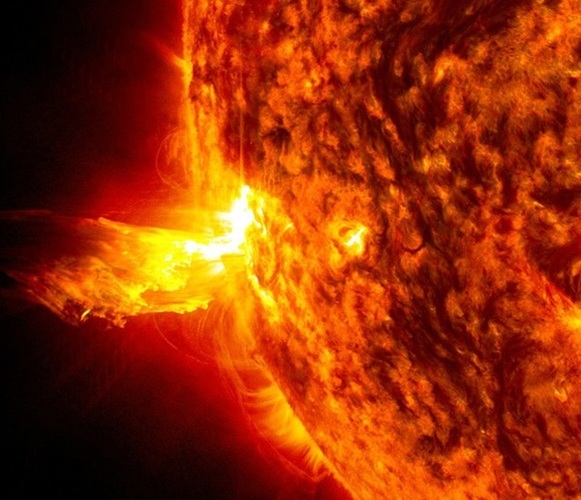
–>
March 23, 2023
A little over a week ago, on Sunday, March 12, a near-catastrophic event occurred that could have wrecked the lives of everyone reading this:
‘); googletag.cmd.push(function () { googletag.display(‘div-gpt-ad-1609268089992-0’); }); }
A Powerful Solar Eruption on Far Side of Sun Still Impacted Earth.
A massive eruption of solar material, known as a coronal mass ejection or CME, was detected escaping from the Sun at 11:36 p.m. EDT on March 12, 2023. The CME erupted from the side of the Sun opposite Earth.
This was a replay of the Carrington event of September 1, 1859:
‘); googletag.cmd.push(function () { googletag.display(‘div-gpt-ad-1609270365559-0’); }); }
Suddenly, [British astronomer Richard Christian] Carrington spotted what he described as “two patches of intensely bright and white light” erupting from the sunspots. Five minutes later the fireballs vanished, but within hours their impact would be felt across the globe.
That night, telegraph communications around the world began to fail; there were reports of sparks showering from telegraph machines, shocking operators and setting papers ablaze. All over the planet, colorful auroras illuminated the nighttime skies, glowing so brightly that birds began to chirp and laborers started their daily chores, believing the sun had begun rising. Some thought the end of the world was at hand…
What happened on March 12 was similar to the 1859 outburst – only worse. Early estimates suggest that this explosion was ten to a hundred times more powerful than the one of 1859. Such events – if not quite so extreme — are not uncommon. One serious difference from 1859 was that explosion took place on the side of the sun facing away from earth. If it had been facing in our direction, if the earth had borne the full brunt of that blast, we can scarcely imagine the results. It’s likely that all operating electrical systems would have been immediately destroyed, the same as the telegraph systems in 1859. Any active electronic instruments – and possibly even those that happened to be shut down – would have been fried, transformed into useless hunks of plastic, metal, and silicon. The electrical and electronic networks (e.g., the Net) that form the framework of Third Millennial civilization would have been annihilated. Once they were destroyed, all power would vanish. Industry would grind to a halt. Massive amounts of data, including almost all financial data, would simply disappear. All methods of communication beyond voice range would no longer exist. It wouldn’t be a matter of waiting to be rescued by a government of any sort. Government would have shrunk to little more than a notion. The very tools on which relief, and even recovery, depend would simply have vanished. The consequences beggar the imagination. A new Dark Age would have been the best option to expect.
 The event did have some effects. Spectacular auroras were seen much farther south than usual. For some hours, radio transmission was down above the Arctic Circle globally. Oddly enough, AT itself may well have been affected. That Sunday night I was on duty, as I usually am, and was just shutting things down when the wave front of this thing struck earth a little after 11:30. My PC immediately slowed down, and certain functions started acting iffy. While putting in the final article graphics, I soon learned that they wouldn’t insert, and that the entire graphics system was useless. After a little work I came up with a plausible hack that I thought would cover things – only to learn the next day that the server was down and not loading any scheduled material. It took AT’s excellent tech team several hours to straighten this out.
The event did have some effects. Spectacular auroras were seen much farther south than usual. For some hours, radio transmission was down above the Arctic Circle globally. Oddly enough, AT itself may well have been affected. That Sunday night I was on duty, as I usually am, and was just shutting things down when the wave front of this thing struck earth a little after 11:30. My PC immediately slowed down, and certain functions started acting iffy. While putting in the final article graphics, I soon learned that they wouldn’t insert, and that the entire graphics system was useless. After a little work I came up with a plausible hack that I thought would cover things – only to learn the next day that the server was down and not loading any scheduled material. It took AT’s excellent tech team several hours to straighten this out.
Very little has been made of this. The media has blithely skipped past it. People who spew bloody froth over “global warming” and other bogosities didn’t so much as twitch, probably because it can’t be blamed on capitalism, industry, or the GOP. Most of the populace is in blissfully ignorant, much the same as a girl I used to know who lived in Carlstadt, a small New Jersey town not far from New York City. A few eeks after she decamped, in dubious circumstances, for the wilds of central Jersey, I learned from the papers – I was in real estate and kept an eye on things in the area – that a 500-lb. aerial bomb had been found in a garage on Garden St. It had been there since WW II, and over the decades had started to deteriorate, the TNT “sweating” nitroglycerin, a highly explosive and extremely unstable compound that settled to the bottom of the casing. That thing could have gone off any time, and it had would have levelled everything on that side of the street for two hundred yards in each direction.
The address of that garage was two doors down from where that girl had been living. For over a years’ time she had spent her days in a rather nice little apartment without much thought or worries while a few steps away instantaneous death slept without her ever knowing it.
‘); googletag.cmd.push(function () { googletag.display(‘div-gpt-ad-1609268078422-0’); }); } if (publir_show_ads) { document.write(“
No doubt there are people out there who can’t understand the CME any more than Mimi did that bomb.
Events like this are valuable in that they lend perspective. One of the major flaws of conservatism is its defeatism. If leftism is apocalyptic, conservatism is chiliastic, always eager for that eschatological moment of doom and judgment. It doesn’t matter what it is – China, Soros, fentanyl, the cartels, CRT, transgenderism – every time a cat falls from a tree, a mob suddenly pops out of hyperspace ready equipped with sackcloth and ashes. The Last Day is always dawning, the seals ever breaking open. There’s an entire school of paleoconservative thought devoted to utter defeatism calling itself the “Remnant,” but more on that at another time.
There are always several doomsdays-of-the-moment making the rounds. A recent example has been a revival of WW III due to the war in Ukraine, that events will at any moment escalate until the siloes open up and the missiles start flying. Well… I have my doubts. If I were Vlad Putin and had spent the last year watching my much-vaunted tanks, fighter-bombers, and Hind gunships falling apart on the front lines, I’d think twice about calling out my far more complex strategic missiles.
Similarly, people – very informed people, scientists of the first rank – had been predicting a return of the Carrington event for fifty years or more, as long as it has been understood what had actually happened. They didn’t know when it was coming; a century, maybe, or a century and a half (my sympathies to those who insisted that it would be 500 years). And they were right – it did come. But not in the manner expected. Because of a very simple aspect of celestial mechanics – the rotation of the sun – all that energy blew off into empty space, and humanity did not go the way of the dinosaurs. The moral is, as a wise man once pointed out, “If you see ten troubles coming down the road, you can be sure nine will run into a ditch before they get to you.”
And what about our poor sun, victimized by its very nature? To my understanding, this event just past resets the clock. We should have little to worry about for another century or so. But on the other hand, we know so little about solar dynamics – astrophysicists are very unclear about what the precise cause of CMEs is, for one thing – that we can’t be certain. We do know that we have two more years before the current solar cycle tops out, and so far, this has been one of the most intense on record.
So take some time to reflect on the bullet that we just dodged, and give thanks that we’re not right this minute battling amid the dark ruins for the last can of baked beans. Life can be terrible, cruel, and harsh, but it also can be none of those things.
Image: Goddard Space Flight Center
<!– if(page_width_onload <= 479) { document.write("
“); googletag.cmd.push(function() { googletag.display(‘div-gpt-ad-1345489840937-4’); }); } –> If you experience technical problems, please write to [email protected]
FOLLOW US ON
<!–
–>
<!– _qoptions={ qacct:”p-9bKF-NgTuSFM6″ }; ![]() –> <!—-> <!– var addthis_share = { email_template: “new_template” } –>
–> <!—-> <!– var addthis_share = { email_template: “new_template” } –>




